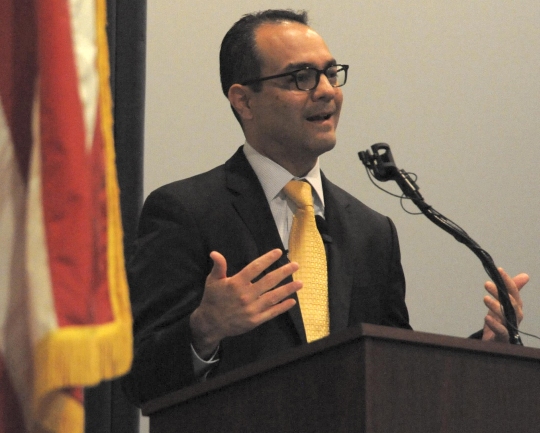 DAHLGREN, Va. - Matthew Swartz - U.S. Fleet Cyber Command Executive Director and Command Information Officer - talks to the audience at Naval Support Facility Dahlgren about the 2016 Asian American and Pacific Islander (AAPI) Heritage Month's national theme: "Walk Together, Embrace Differences, Build Legacies." Swartz weaved personal stories about growing up at the Dahlgren naval base into his keynote speech. ""In those journeys I used to take with her, I learned from her differences to the point where I finally got comfortable with our differences and started to embrace them," said Swartz about long walks he would have with his mother and his differences as an American with Japanese ethnicity. "I no longer tried to hide them, which was interesting." (U.S. Navy photo by Patrick Dunn/Released)
DAHLGREN, Va. - Matthew Swartz - U.S. Fleet Cyber Command Executive Director and Command Information Officer - talks to the audience at Naval Support Facility Dahlgren about the 2016 Asian American and Pacific Islander (AAPI) Heritage Month's national theme: "Walk Together, Embrace Differences, Build Legacies." Swartz weaved personal stories about growing up at the Dahlgren naval base into his keynote speech. ""In those journeys I used to take with her, I learned from her differences to the point where I finally got comfortable with our differences and started to embrace them," said Swartz about long walks he would have with his mother and his differences as an American with Japanese ethnicity. "I no longer tried to hide them, which was interesting." (U.S. Navy photo by Patrick Dunn/Released)DAHLGREN, Va. (June 16, 2016)—Matthew Swartz recounted the day his brother signed up at the Virginia Army National Guard unit in Fredericksburg, Va., shortly after 9/11.
"He was out of the Army for 10 years and just had his second daughter, less than a year old," said Swartz. "He had a very stable job as a police officer, and his first daughter was about to graduate from high school."
Swartz—the Executive Director and Command Information Officer for U.S. Fleet Cyber Command—was speaking to his audience at the Naval Support Facility Dahlgren base theater about the 2016 Asian American and Pacific Islander (AAPI) Heritage Month's national theme: "Walk Together, Embrace Differences, Build Legacies."
"You can imagine the conversation in his household with his wife when he told her that he was departing for Iraq in less than a month—after making that decision without talking to her," said Swartz.
"Who would do that," he questioned, as military members, government civilians, and defense contractors listened to the keynote speaker at the May 24 Naval Surface Warfare Center Dahlgren Division (NSWCDD)-sponsored event.
"I think a lot of the culture and attributes that my mother instilled in him in terms of hard work," explains who would do that, said Swartz. "They trained you to do a job, you're expected to do the job, and you're expected to do the best you can."
Moreover, Swartz recalled the day his brother deployed as a member of the 29th Infantry Division out of Mary Washington College with a combat badge on his shoulder. "None of the 29ers had it," said Swartz who quoted his brother's comment: "There's not a single guy there wearing a CIB (combat infantry badge). How can I be from this town with this training and let that unit go forward without me?"
Swartz considered the story as an example of "walking together"—the first component of an AAPI Heritage Month theme that defined the struggles Asian-Americans and Pacific Islanders faced and overcame in a process that was not always favorable.
"I take a lot of pride in what he's contributed and provided," said Swartz. "It's one reason that I continue to do what I do in the Navy as a civilian. It's the sense of commitment and I think that's why we are all here. It's because we are committed to the mission. We are committed to what we do every day and we want to do it the best we can, whether we are wearing a uniform or whether we are wearing a suit. And you have to embrace those differences. I think those differences are what inspired him to do what he does."
This year's three imperatives—walk together, embrace differences, and build legacies—serve to promote equal representation and to remove barriers in developing diverse leaders, acknowledging the challenges that still exist today.
"It's an exciting time for me to celebrate our heritage and talk to you about the contributions of the (AAPI) members that are part of our Navy team today, but also those who came before us, recognizing the contributions that they provided," said Swartz. "This is an opportunity for me. I am of Japanese heritage. My mother was first generation Japanese. She married an American GI during the Vietnam War while he was stationed in Japan, and eventually found herself coming to the United States."
Swartz reminisced about growing up on the Dahlgren naval base while his father worked as a government employee. The stories clearly credit his mother and her diversity with shaping him to be who he is today.
"If you walk together, embrace differences, embrace each other, and take what you have from each other to do the best that you can as a collective unit—you will build a legacy," said Swartz. "You don't have to try to build it. I take a lot of pride in my family legacy. We have a pretty robust military background, military heritage, and commitment to service. That's a legacy that we built as a family. If you can find a legacy that you will take pride in or that you're going to own, I think you will achieve that, and you're going to get an inspiration in that."
Swartz managed to simultaneously work full-time in a factory and part-time at a bank holding company while drilling as an active Army reservist and attending Mary Washington College where he earned his bachelor's degree. He went on to earn master of science degrees from the University of Virginia and the Industrial College of the Armed Forces National Defense University.
"I think the traits of hard work and dedication will enable you to find out your path and help provide the things you need," said the cyber command senior executive. "So that's walking together—what you need to do."
He mentioned another personal example of walking together.
"In those journeys I used to take with her, I learned from her differences to the point where I finally got comfortable with our differences and started to embrace them," said Swartz about long walks he would have with his mother and his differences as an American with Japanese ethnicity. "I no longer tried to hide them, which was interesting."
Swartz and NSWCDD Commanding Officer Capt. Brian Durant reviewed examples of Asian American and Pacific Islander lives and legacies that are bigger than the individual legacy.
"I want to pay homage to the folks who came before us. It's important to understand who paved the way for us," said Swartz, recalling legacies of Asian American and Pacific Islanders, including Florence Smith Finch, Col. Young-Oak Kim, and U.S. Sen. Daniel Inouye.
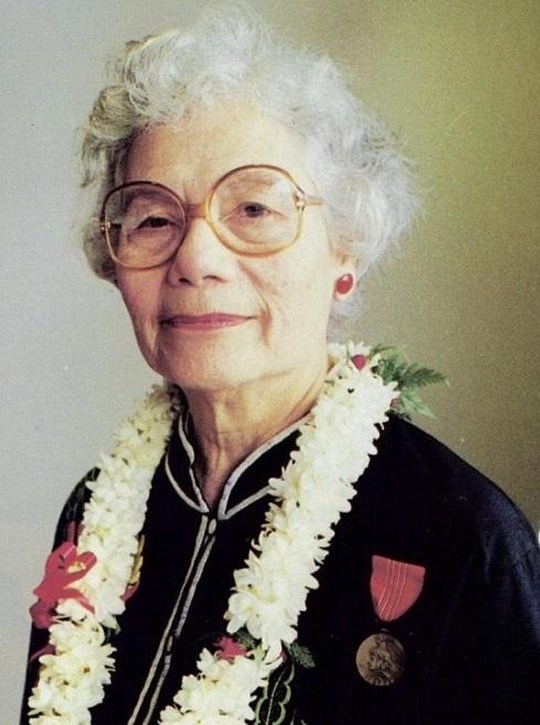 Florence Smith Finch, the daughter of an American soldier and a Filipino mother, who was working for the U.S. Army during World War II when the Japanese occupied the Philippines. Claiming Filipino citizenship, she avoided being imprisoned with other enemy nationals at Santo Tomas Internment. She joined the underground resistance movement and smuggled food, medicine, and supplies to American captives.
Florence Smith Finch, the daughter of an American soldier and a Filipino mother, who was working for the U.S. Army during World War II when the Japanese occupied the Philippines. Claiming Filipino citizenship, she avoided being imprisoned with other enemy nationals at Santo Tomas Internment. She joined the underground resistance movement and smuggled food, medicine, and supplies to American captives.• Florence Smith Finch, the daughter of an American soldier and a Filipino mother, who was working for the U.S. Army during World War II when the Japanese occupied the Philippines. Claiming Filipino citizenship, she avoided being imprisoned with other enemy nationals at Santo Tomas Internment. She joined the underground resistance movement and smuggled food, medicine, and supplies to American captives. Eventually, she was arrested by the Japanese, tortured, and sentenced to three years imprisonment. After serving five months of her sentence, Finch was liberated by American forces. Returning to the United States aboard a Coast Guard transport, she headed for Buffalo, New York, her father's hometown. She then enlisted in the Coast Guard to "avenge the death of her late husband," a Navy PT boat crewman killed at Corregidor. Seaman First Class Finch was the first U.S Coast Guard Women's Reserve member to receive the Asian-Pacific Campaign ribbon in recognition of her service in the Philippines. At the end of the war, she was awarded the civilian U.S. Medal of Freedom.
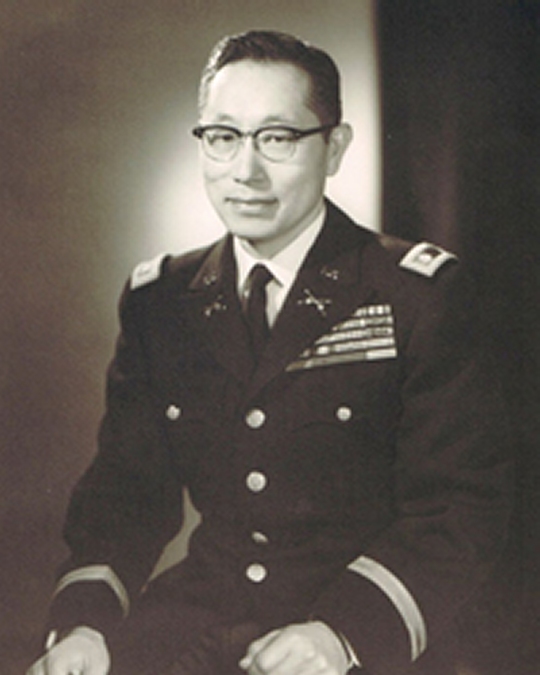 Col. Young-Oak Kim. In 1951, Kim was the First Asian-American to lead a combat battalion in a war. Kim is also the only Korean-American to be awarded the Distinguished Service Cross for his actions at the Battle of Anzio during World War II. Kim, having reenlisted and promoted to major, became the first ethnic minority to command a regular combat battalion, the first of the 31st Infantry.
Col. Young-Oak Kim. In 1951, Kim was the First Asian-American to lead a combat battalion in a war. Kim is also the only Korean-American to be awarded the Distinguished Service Cross for his actions at the Battle of Anzio during World War II. Kim, having reenlisted and promoted to major, became the first ethnic minority to command a regular combat battalion, the first of the 31st Infantry.• Col. Young-Oak Kim. In 1951, Kim was the First Asian-American to lead a combat battalion in a war. Kim is also the only Korean-American to be awarded the Distinguished Service Cross for his actions at the Battle of Anzio during World War II. Kim, having reenlisted and promoted to major, became the first ethnic minority to command a regular combat battalion, the first of the 31st Infantry. When then-2nd Lt. Young Oak Kim reported for duty at Camp Shelby, Miss., in February 1943, the commander of the 100th Battalion (Separate), Lt. Col. Farrant Turner, offered him an immediate transfer because "Koreans and Japanese don't always get along." Kim refused on the spot: "You're wrong. They're Americans, I'm American, and we're going to fight for America." The young Korean-American lieutenant was being both patriotic and pragmatic. Born in 1919 in downtown Los Angeles; amid Japanese, Chinese, Mexican, and Jewish immigrants, Kim knew his opportunities for advancement would be limited in a "white man's army." "If I wasn't with the 100th," Kim recalled many years later, "I would be a PR [Public Relations] officer or have some insignificant duty someplace else, because nobody was going to let me, as an Asian, command regular troops."
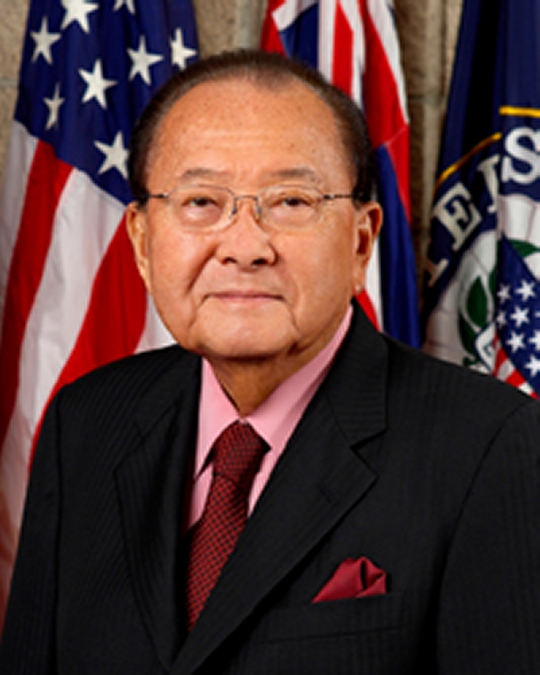 Sen. Daniel K. Inouye. In 2000, he was the first Japanese-American and only second recipient to receive both the Medal of Freedom and the Medal of Honor. Inouye is also the first Japanese-American to serve in Congress. On Dec. 7, 1941, the fateful day of the Japanese attack on Pearl Harbor, 17-year-old Inouye was one of the first Americans to handle civilian casualties in the Pacific war. During World War II, Inouye served in the U.S. Army's 442nd Regimental Combat Team. Composed of Soldiers of Japanese ancestry, the 442nd became one of the most decorated military units in U.S. history. For his combat heroism, which cost him his right arm, Inouye was awarded the Medal of Honor, the Distinguished Service Cross, the Bronze Star, and the Purple Heart with Cluster.
Sen. Daniel K. Inouye. In 2000, he was the first Japanese-American and only second recipient to receive both the Medal of Freedom and the Medal of Honor. Inouye is also the first Japanese-American to serve in Congress. On Dec. 7, 1941, the fateful day of the Japanese attack on Pearl Harbor, 17-year-old Inouye was one of the first Americans to handle civilian casualties in the Pacific war. During World War II, Inouye served in the U.S. Army's 442nd Regimental Combat Team. Composed of Soldiers of Japanese ancestry, the 442nd became one of the most decorated military units in U.S. history. For his combat heroism, which cost him his right arm, Inouye was awarded the Medal of Honor, the Distinguished Service Cross, the Bronze Star, and the Purple Heart with Cluster.• Sen. Daniel K. Inouye. In 2000, he was the first Japanese-American and only second recipient to receive both the Medal of Freedom and the Medal of Honor. Inouye is also the first Japanese-American to serve in Congress. On Dec. 7, 1941, the fateful day of the Japanese attack on Pearl Harbor, 17-year-old Inouye was one of the first Americans to handle civilian casualties in the Pacific war. During World War II, Inouye served in the U.S. Army's 442nd Regimental Combat Team. Composed of Soldiers of Japanese ancestry, the 442nd became one of the most decorated military units in U.S. history. For his combat heroism, which cost him his right arm, Inouye was awarded the Medal of Honor, the Distinguished Service Cross, the Bronze Star, and the Purple Heart with Cluster. He practiced law in Hawaii before entering territorial politics in 1954. When Hawaii became the 50th state, Inouye was one of its first representatives in the U.S. Congress. He won an election to the U.S. Senate in 1962. Inouye served as the Senate's president pro tempore from 2010 until his death in 2012. In 2013, Inouye was posthumously awarded the Presidential Medal of Freedom, becoming the first senator to receive both the Medal of Freedom and the Medal of Honor.
"Asian American and Pacific Islanders have been serving honorably in the United States Military since the War of 1812," said Durant. "The first Asian American Pacific Islander to reach general officer rank was Brig. Gen. Albert Lyman, who was ethnic Hawaiian. He was the commanding general of the 32nd Army Division that fought in the Leyte campaigns in the Philippines in World War II. The highest ranked Asian American Pacific Islander in the military was Eric Shinseki, recently former four-star general and Army chief of staff."
Durant also recalled legacies of Asian American and Pacific Islanders Susan Ahn Cuddy, Major Kurt Chew-Een, and Rear Adm. (Gordon Pai'ea) Chung-Hoon.
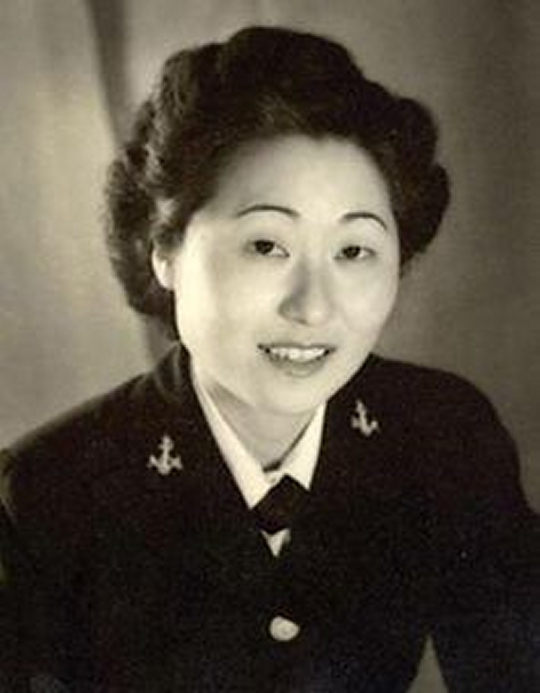 Susan Ahn Cuddy joined the Navy in 1942 after Japan bombed Pearl Harbor. She was the first Asian-American woman to join the U.S. Navy and became the first female to operate flexible-mount or turret-mounted machine guns on an aircraft in the Navy. She left the Navy in 1946 at the rank of Lieutenant.
Susan Ahn Cuddy joined the Navy in 1942 after Japan bombed Pearl Harbor. She was the first Asian-American woman to join the U.S. Navy and became the first female to operate flexible-mount or turret-mounted machine guns on an aircraft in the Navy. She left the Navy in 1946 at the rank of Lieutenant.• Susan Ahn Cuddy joined the Navy in 1942 after Japan bombed Pearl Harbor. She was the first Asian-American woman to join the U.S. Navy and became the first female to operate flexible-mount or turret-mounted machine guns on an aircraft in the Navy. She left the Navy in 1946 at the rank of Lieutenant. Even in her elder years, Susan remained active, speaking at Navy functions and Korean American community events. She died at her home June 24, 2015 at aged 100 in Northridge, California.
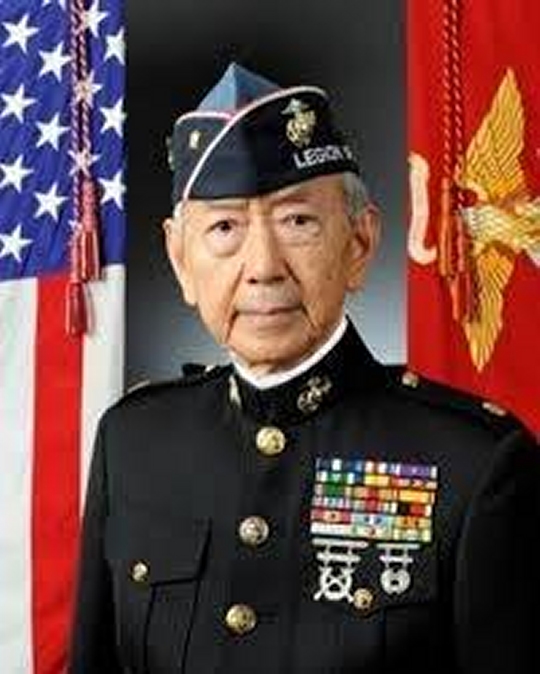 Maj. Kurt Chew-Een Lee, the first Marine officer of Chinese descent, broke barriers of segregation upon his 1944 Marine Corps enlistment, retiring as a Major in 1968. Lee earned the Navy Cross under fire in Korea in September 1950.
Maj. Kurt Chew-Een Lee, the first Marine officer of Chinese descent, broke barriers of segregation upon his 1944 Marine Corps enlistment, retiring as a Major in 1968. Lee earned the Navy Cross under fire in Korea in September 1950.• Maj. Kurt Chew-Een Lee, the first Marine officer of Chinese descent, broke barriers of segregation upon his 1944 Marine Corps enlistment, retiring as a Major in 1968. Lee earned the Navy Cross under fire in Korea in September 1950. He passed away in 2014. He remains a prominent symbol for AAPI Heritage Month and Lee is recognized alongside all Asian-Americans and Pacific Islanders within the Marine Corps.
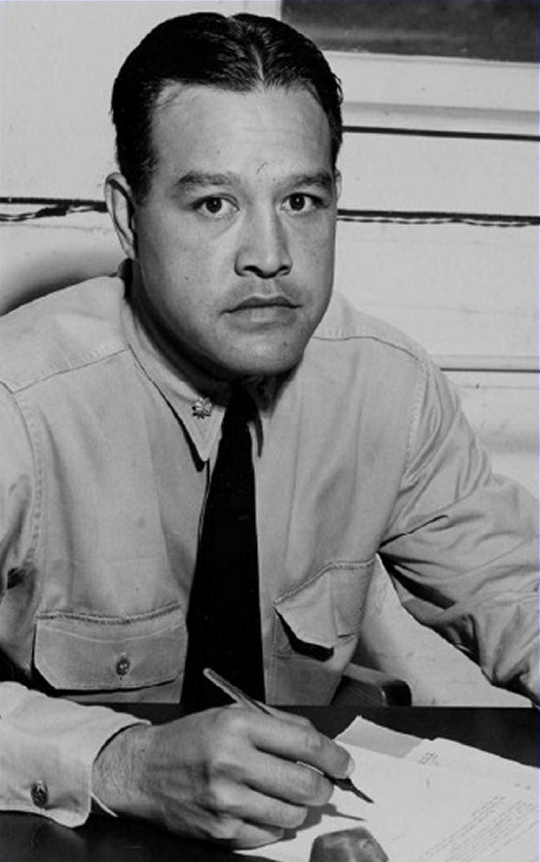 Rear Adm. (Gordon Pai'ea) Chung-Hoon served during World War II and became the U.S. Navy's first Asian American flag officer. He attended the United States Naval Academy, graduating in 1934, after becoming the first Asian American, U.S. citizen to graduate from the academy. He is a recipient of the Navy Cross and Silver Star for extraordinary heroism as commanding officer of USS Sigsbee from May 1944 to October 1945.
Rear Adm. (Gordon Pai'ea) Chung-Hoon served during World War II and became the U.S. Navy's first Asian American flag officer. He attended the United States Naval Academy, graduating in 1934, after becoming the first Asian American, U.S. citizen to graduate from the academy. He is a recipient of the Navy Cross and Silver Star for extraordinary heroism as commanding officer of USS Sigsbee from May 1944 to October 1945.• Rear Adm. (Gordon Pai'ea) Chung-Hoon served during World War II and became the U.S. Navy's first Asian American flag officer. He attended the United States Naval Academy, graduating in 1934, after becoming the first Asian American, U.S. citizen to graduate from the academy. He is a recipient of the Navy Cross and Silver Star for extraordinary heroism as commanding officer of USS Sigsbee from May 1944 to October 1945. He served 25 years in the U.S. Navy and retired as an admiral. He died July 24, 1979 at age 68.


